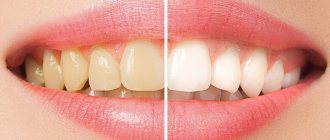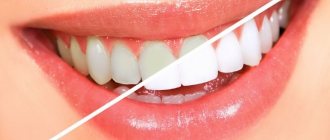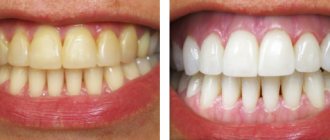Date of publication: 18-01-2019 Date of update: 17-02-2021
Author of the publication: Bogatyreva Radima Muradinova Periodontist
The whitening procedure is often perceived as aesthetic, but it also has many positive properties in terms of health improvement. Sometimes patients refuse a snow-white smile because they are embarrassed to discuss the procedure with a dentist or believe myths from the Internet. In this article you will find answers to the most popular questions about teeth whitening that are asked to dentists at the Clarimed clinic.
When is whitening needed?
Different people have different shades of enamel. This is due to genetics, lifestyle, and the quality of hygiene procedures. Changing the color of teeth can have several reasons:
- insufficient oral care;
- artificial or natural colors contained in food;
- bad habits;
- jaw injuries, some systemic diseases;
- taking medications;
- age-related changes.
If any of these reasons are present in your life, or you simply want to lighten your enamel a few shades to make your smile look healthier and more beautiful, this is an indication for whitening.
Why does a dead tooth turn dark?
Teeth that lack nerves inside are considered dead. The surface of such processes is characterized by a tendency to change color and the appearance of dark spots. The reasons for the darkening of a pulpless tooth are as follows:
- lack of food. After the nerve is removed, the power to the tooth stops. Moisture leaves the enamel, nutrients are not supplied by the nerve endings, which leads to darkening;
- increased vulnerability. Without regular feeding, the tooth becomes very vulnerable. Pores form on the surface of the enamel, through which various coloring substances from the food consumed penetrate into the internal tissues. These dyes change the color of the enamel.
These are the most common reasons why tooth enamel darkens. In such cases, superficial bleaching of the dead tooth will help restore whiteness. But there are also often cases where a tooth has lost its original color due to bleeding during pulp removal. As a result, the enamel becomes reddish or purple. Classic whitening will not provide results in such situations; a more complex procedure will be required.
Does the procedure have any contraindications?
As with any manipulation in the dental chair, there are contraindications, but not many of them:
- pregnancy and breastfeeding;
- oncological diseases;
- allergies to the drugs used.
All other problems - caries, inflammation of the oral mucosa and gums - are considered relative contraindications. After they are eliminated, bleaching can be done.
Even if you take good care of your teeth, whitening will have the effect of making your smile even more aesthetically pleasing.
Contraindications and side effects of whitening filled teeth
It is possible to whiten teeth with fillings, but you need to consider the following possible side effects:
- the appearance of external grooves on the enamel leads to an increase in sensitivity under stress during eating;
- within 3-4 days, sensitivity to chemical and temperature influences increases - you should not eat too cold or hot food;
- contact trusted clinics, as failure to follow the technology can lead to irritation of the gums accompanied by a burning sensation;
- During the process of whitening the filling, the gel may enter the cavity.
The procedure is prohibited in the following cases: during pregnancy and breastfeeding, diseases of soft and bone tissues, allergic reactions, etc. Only a dentist can say for sure whether and how to whiten teeth with fillings after an examination.
Which teeth should not be whitened?
Whitening is not carried out if there is untreated caries in the oral cavity, exposed tooth necks, or enamel damage. If there are composite fillings, the procedure will give an uneven effect, because the color of inorganic materials is not subject to change. The most correct thing would be to install a temporary filling and carry out whitening before the final restoration of the tooth.
The procedure is also not carried out in the presence of braces due to the unguaranteed and uneven result. Exposure to chemicals on the enamel of hypersensitive teeth is undesirable.
What is laser whitening? Is it true that it is the most effective?
Laser whitening/photo whitening (I came across other names) - all of this is essentially the same thing. In order to stand out from the crowd and offer patients something “unique... and only here,” clinic advertisers come up with a bunch of names for the same procedure. All this is standard whitening with gels, which are activated by the light of special lamps. Indeed, such systems (Zoom, LumaCool, LumaArch and many others) give the fastest and most noticeable results. But at the same time they also give the greatest number of cases of the development of very intense hypersensitivity. Plus, due to the rather high cost of consumables required for each procedure, the high cost of the lamp itself, which must be “beaten”, the price for such a service turns out to be the highest of all possible options for whitening procedures. But the choice is ultimately yours. Do you want instant results visible to the naked eye? Pay with money and discomfort from pain. Do you want it cheaper and with a minimum of discomfort? Then be patient and forget about “laser” whitening.
The generation of advertisers who grew up watching Star Wars apparently imagines the dentists of the future in this way, luring patients to clinics for “laser treatment of caries,” “laser whitening,” and “laser implantation.”
In fact, this is what the Zoom lamp for “laser” (i.e., actually conventional, light-activated) whitening looks like these days.
How to whiten teeth at home?
All chemical preparations for teeth whitening at home, as well as professional ones, contain peroxide gels. They are applied using different devices:
- mouth guards – “covers” for teeth made of hypoallergenic plastic. They are filled with a special gel and worn for several hours a day;
- adhesive strips - stickers on teeth already impregnated with hydrogen peroxide or urea. A thirty-minute daily procedure will help brighten your smile by one or two shades in just a month;
- whitening gels and pencils - used in the same way as strips.
But Clarimed specialists recommend visiting a dentist before starting home whitening; our clinic even offers a free consultation; don’t risk the health of your teeth.
Is it possible to whiten metal-ceramic crowns?
Unfortunately, it is impossible to achieve perfect whitening of fillings and metal-ceramic crowns. So, for example, modern dental ceramics is a fairly dense and hard material, so the brightening compounds used today have practically no effect on it.
The photo shows a metal-ceramic crown
But if the restored areas and prosthetic structures are located in the posterior parts of the jaw, the front teeth can be whitened. Then the difference in shades will not be noticeable. Otherwise, it will not be possible to achieve uniform whitening and an aesthetically pleasing smile. To do this, you will have to look for other solutions to the problem.
Is it possible to whiten teeth at home?
Home whitening has a serious limitation - it does not carry risks if it is carried out on absolutely healthy teeth. If the neck of the teeth is exposed, there are cracks in the enamel and carious cavities, such procedures will only cause harm. Before using chemical gels, you should consult your dentist.
Folk remedies that are recommended for whitening are no less traumatic for enamel than professional chemical ones. The use of soda, charcoal, and lemon juice sometimes causes more harm than bad habits or injuries.
How to paint metal ceramics
One of the options for lightening fillings and crowns is to stain them. For this purpose, various compositions are used today: liquid enamel, professional dental paints and varnishes. Recently, Dental Paint has gained particular popularity. One of its main advantages is that it allows you to paint even hard-to-reach places, and also successfully solves the problem of darkening of filling materials, crowns and dentures. With its help, you can achieve lightening of up to 10 tones, and at the same time the result will look natural1.
Dental Paint can be used to lighten teeth
However, this method also has one significant drawback - the effect will be short-lived, so the procedure will soon have to be repeated. This method is similar to applying makeup, because the paint will be washed off after the first brushing of your teeth. Yes, and you cannot use such products on an ongoing basis, since this can lead to the destruction of the filling or crown. The materials from which they are made do not absorb paint, so it is impossible to change their color in this way. In such cases, dental experts recommend timely replacement of restorative materials and prostheses.
How often do you need to perform the whitening procedure to maintain the effect?
Teeth whitening using chemicals changes the condition of the enamel. Therefore, doctors do not recommend performing it more often than once every 2 years. Between procedures it is recommended:
- For the first month, avoid food and drinks with active dyes - red wine, coffee, brightly colored vegetables.
- Quit smoking - nicotine will quickly return the yellowish tint.
- Visit your doctor regularly to get rid of plaque and tartar.
- Use threads, special pastes, and electric brushes in home care.
Plastic dentures. Features of care
Not everyone has the opportunity to install expensive metal-ceramic teeth. An alternative in this case is budget plastic. This material is quite reliable and is able to maintain its original whiteness throughout its entire service life with proper care.
But the question of how to whiten plastic dentures arises when eating foods that have coloring properties. Smoking leaves its mark plus bad breath.
To remove plaque, special products are offered - Protefix, Corega, Rox. On average, once a month, the tablet is dissolved in water and a removable plastic structure is placed in the resulting solution for the time specified in the instructions. This procedure allows you to preserve the shade and extend the service life.
You can solve the problem of how to whiten dentures by contacting a specialized clinic. Specialists will select the necessary products to restore color.
Are preparatory procedures necessary before lightening tooth enamel?
The process of preparing for teeth whitening takes place in several stages:
- examination of the dentist and identification of absolute and relative contraindications;
- sanitation of the oral cavity and installation of temporary fillings, if necessary;
- removal of tartar, plaque, polishing and fluoridation.
A few weeks before the procedure, it is advisable to start a course of medications to reduce sensitivity and strengthen the enamel. The doctor will recommend special gels and pastes for treating teeth.
At the patient’s request, the dentist will take impressions to make a special mouth guard for subsequent use at home. This will help prolong the effect of the professional procedure.
Carry out the whitening procedure at the Clarimed clinic, we guarantee excellent results
How effective and harmful are whitening toothpastes?
Here it must be said that the vast majority of so-called whitening pastes are actually not capable of whitening anything, because... they simply lack an oxidizing agent. So this is a kind of advertising ploy by the manufacturers. But what they do have is a higher content of abrasive substances for more effective plaque removal. You should not use such toothpastes regularly; it can cause serious harm to your teeth. At a minimum, this may threaten the appearance of increased sensitivity of teeth , and at a maximum, the appearance of non-carious lesions (mainly wedge-shaped defects). They can be used only temporarily (no more than one medium tube is used up) and it is advisable to alternate it with regular toothpaste. It is needed primarily by heavy smokers and coffee lovers. If you are not one of them, then you should not turn your attention to “whitening” toothpastes. In some rare cases, whitening toothpastes do contain small amounts of a bleaching agent. And such a paste really has the right to be called “whitening.” They are sold more often in pharmacies and are much more expensive than regular pastes. But even with regular use, you should not count on a noticeable effect from their isolated use. Concentrations are too low. As a rule, they are used for the period while the home whitening process is in progress to enhance and maintain the effect.
Here you can also talk about other “pharmacy” products for teeth whitening – various varnishes, strips, etc. All of these are very ineffective drugs for the same reason - a low concentration of the bleaching agent. To feel the results from them, you need to have a very high power of self-hypnosis. So it's just wasted money.
How does non-professional whitening affect tooth enamel?
Frequent and uncontrolled use of chemicals for treating teeth leads to the gradual destruction of enamel. It becomes more porous, absorbs dyes faster, becomes cracked and loses its whiteness. The decrease in mineralization of the outer layer and its destruction can be partially compensated with the help of fluorine-containing preparations.
But provided that the whitening procedure is carried out in a dental clinic, in compliance with the recommendations of the attending physician, all risks and negative consequences will be minimized.
We hope that the whitening procedure is now clearer to you and you are ready to achieve a Hollywood smile. Call or sign up on the website:
We also recommend paying attention to the popular service - installation of veneers - snow-white teeth like superstars!
Teeth with filling. Can they be snow white?
It is necessary to clearly distinguish between the front teeth and the chewing teeth. And if you have a filling on the front row of teeth, then you can forget about whitening - it will only make it worse. This is due to the fact that the tooth enamel will acquire a lighter shade, and the filling will remain the same as it was before. Do you want stained teeth with uneven coverage? We think not. But don't despair. If you still need a snow-white smile, then you can ask your dentist to replace the filling with a new one, matched to the color of your whitened teeth. This is not a cheap procedure, but it is worth it. There is another interesting solution - installing veneers. They allow you to make all your teeth uniform, snow-white, and fix this result for a long time. Dental veneers are thin shells of ceramic that are placed on the teeth. This makes it snow white. Not so expensive, but requires quite a lot of time to manufacture and fit. Pay attention to this.
Of course, if you only have fillings on your back chewing teeth, then you can whiten your teeth without any problems! The smile will be snow-white, and no one will notice the differences in color! So, do not despair ahead of time - consult a specialist. He will be happy to help you with this problem.
Prices for installing a light seal
The cost of installing a light filling will largely depend on the dental disease that needs to be treated and also on the volume of filling material required for high-quality tooth restoration. If you need to put a small light filling on a tooth, then the price of the service can vary between 2000 -3000 rubles. Large fillings for caries that have severely damaged teeth are more expensive - from 3,000 to 4,000 rubles.
Installing a filling for pulpitis and periodontitis will cost even more. Here the price of treatment will range from 5 to 10,000 rubles.
You can find out the exact cost of a light filling only after visiting the dentist’s office and undergoing an examination! We would like to draw your attention to the following point: the service life of light fillings depends on the quality of the materials and on the level of professionalism of the doctor who will carry out the treatment and restoration of the tooth. The risks of complications after installing a filling also depend on these factors. If the doctor makes mistakes when treating deep caries and pulpitis, the tooth under the filling may begin to hurt. Naturally, a poorly installed seal can chip or fall out at any time. Therefore, when planning to put light fillings on your teeth, always carefully choose dentistry for your treatment!
Calculate the cost of treatment by taking a short test in 20 seconds!
Do not delay your treatment, because in this matter time plays against us.
What is important in the first 2 weeks after placing a filling?
Immediately after the filling is placed, the material is not yet completely polymerized and may have micropores that are easily filled with coloring food products. This could be wine, chocolate, berries and other “bright” foods. Try not to eat such tasty things and not drink red wine for the first two weeks, but if it is simply impossible, immediately after eating, rinse your mouth with water and, if possible, brush your teeth with a toothbrush and toothpaste. After 2 weeks, a high-quality filling will no longer be stained.










